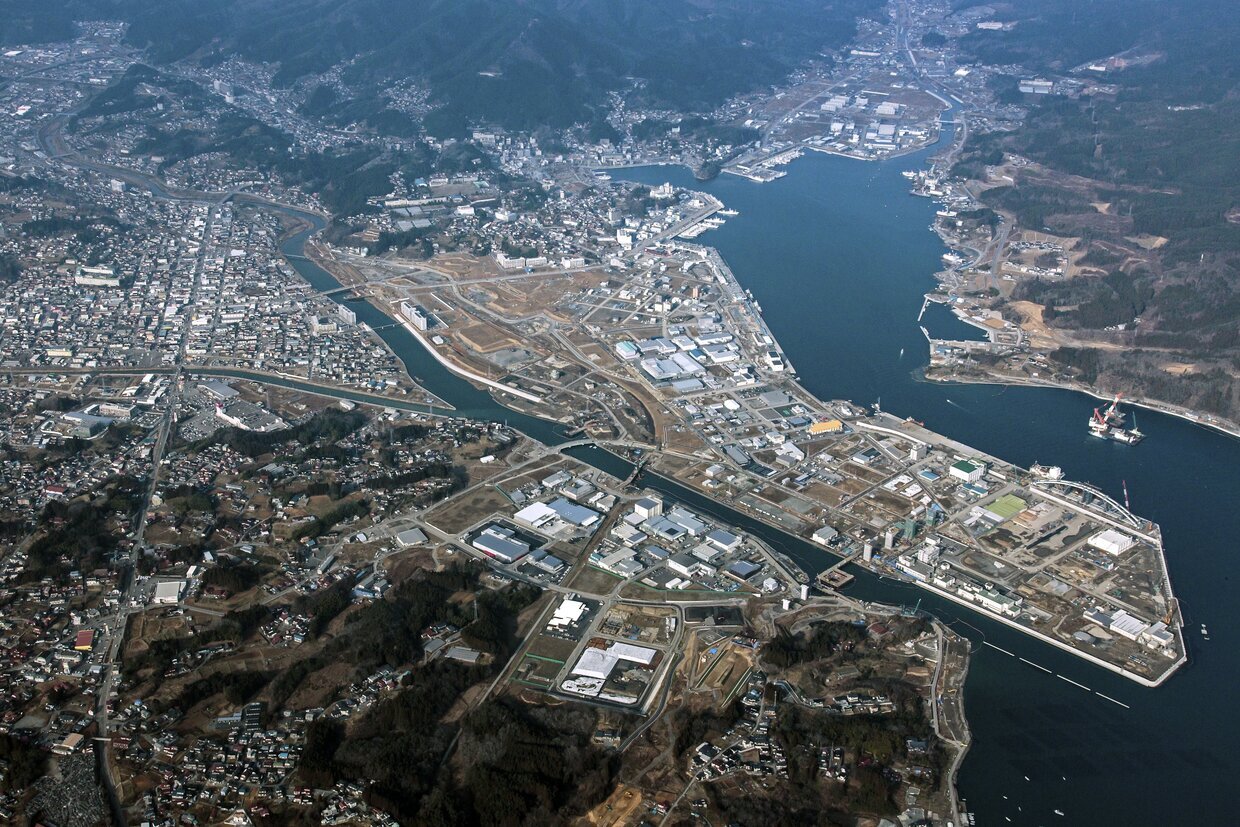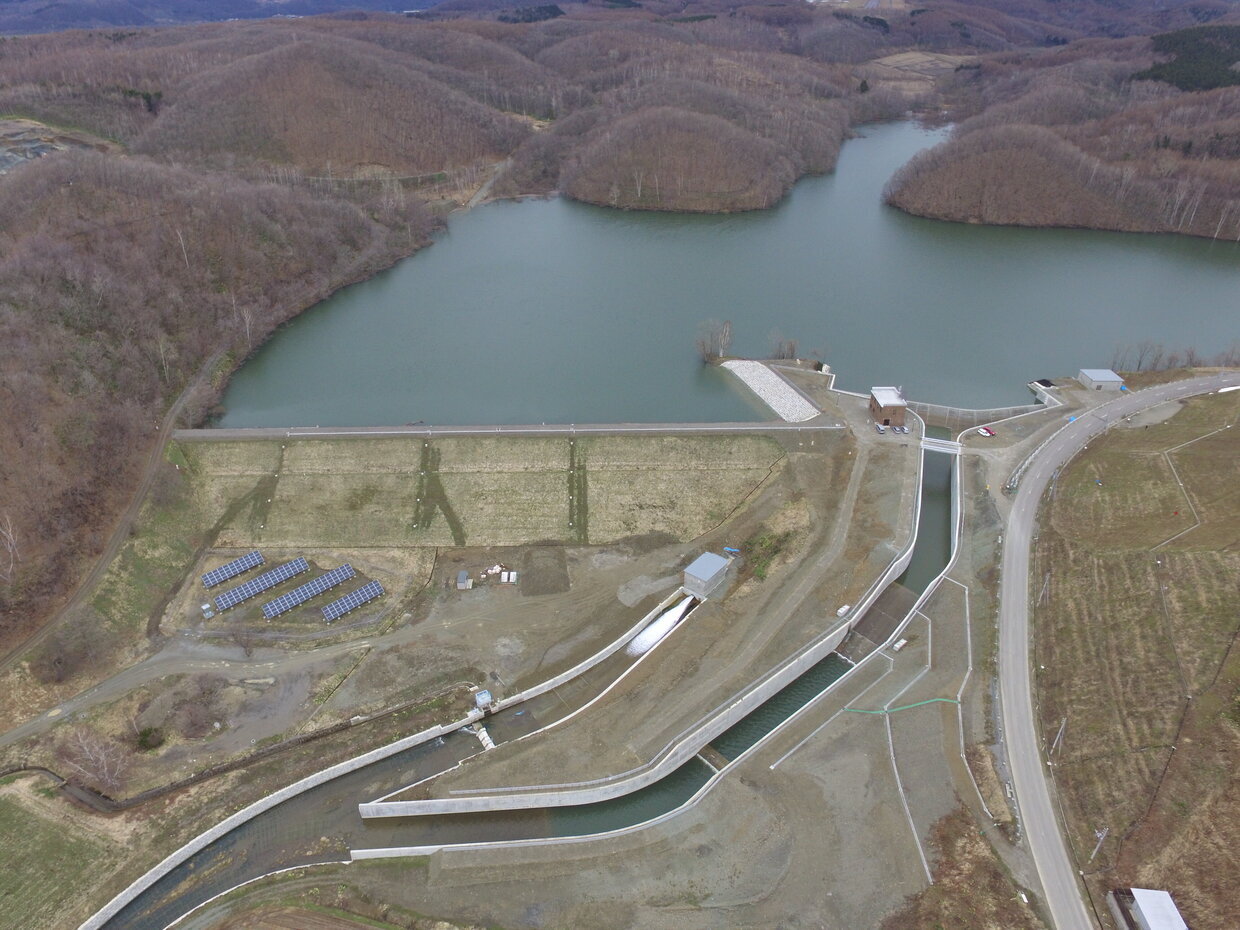Strengthening Earnings Capacity (2) Civil Engineering Business
Greater Efficiency and Visualization
Similarly to the Building Construction Division, the Civil Engineering Construction Division also endeavored to increase productivity at construction sites. An action plan was established with the goal of increasing on-site productivity by 5 percent. The company focused on reviewing on-site operations, strengthening on-site support by back offices, reviewing the assignment plan of on-site personnel, and passing on on-site skills. For the review of on-site operations, ICT was used to increase productivity, through initiatives such as introducing a smartphone-based vehicle operation management system, creating data on worker accident compensation insurance (wage ledgers) using an electronic daily reporting system, and sharing examples of operational improvements via the intranet.
The development of BIM in the Building Construction Division was followed by the Civil Engineering Construction Division’s introduction of Construction Information Modeling (CIM). CIM creates 3D models of civil engineering structures on a computer screen, so users can visualize the construction process and imagine the completed structures with ease. CIM is also effective for sharing information with suppliers and subcontractors and facilitates discussions on design changes. CIM reduces backtracking during construction, and incorporating its functions in process has also lead to shortened construction periods.
Furthermore, the CIM Promotion Section was established in the PD Center, which was reorganized from the BIM Promotion Department under the Building Construction Division in October 2013. The section was created to integrate the knowledge of BIM that was introduced ahead of CIM to promote CIM initiatives more efficiently.
Execution of Disaster Reconstruction Work
In the immediate aftermath of the Great East Japan Earthquake, Obayashi Corporation engaged in more than 300 emergency disaster recovery projects and was also involved in the disposal of debris generated by the disaster as well as decontamination. Following the recovery work, the company worked with local residents on various community development projects that were underway for reconstruction, such as the construction of housing for people affected, infrastructure development, and land development for the relocation of residents to higher ground.
Reconstruction projects are being carried out in seven districts in the town of Yamada in Iwate Prefecture, which suffered devastating damage from the tsunami. In April 2013, a joint venture led by Obayashi Corporation was awarded contracts for two of these districts, Yamada and Orikasa, and adopted the construction management (CM) system for these projects. The same CM system was used for the earthquake reconstruction project in the Katagishi and Unosumai districts of Kamaishi City, about 20 kilometers south of Yamada Town.
At the request of Kesennuma City in Miyagi Prefecture, the company rebuilt a fish processing complex that was severely damaged by the tsunami in the city’s Akaiwa Port where fish processing plants are concentrated.

In the fisheries processing complex construction project in Miyagi Prefecture (20 hectares), 430,000 cubic meters of the 1.01 million cubic meters of soil cut from slopes and other areas were reused as banking material. Efforts were also made to reduce carbon dioxide emissions through the use of ICT in construction machinery. These initiatives were awarded the Minister of Land, Infrastructure, Transport and Tourism’s Prize of the FY2017 3Rs (Reduce, Reuse, and Recycle) Promotion Merit Awards.
In Sendai City, the company carried out emergency works to prevent residential land in the Yagiyama district from sliding and collapsing. In Izumi-chuo-minami, the Company also purchased privately built housing and repurposed it into publicly operated housing, which provided a permanent residence for people who had lost their homes. The residents were selected from among members of the public through a public ballot. Additionally, the company raised and widened the levee along Saragai River in Miyagi Prefecture, for a total of 10 kilometers on both sides of the river. The levee had sunk during the earthquake and collapsed from the tsunami. The company also restored a part of the JR Joban Line that was damaged by the tsunami.
(Reference: Special Contents > Six Stories > Great East Japan Earthquake)
Under the sector-specific measures in the Medium-Term Business Plan ’12, Obayashi Corporation developed social infrastructure for safety and security, including for disaster preparedness and mitigation. The company strengthened its marketing structure for disaster preparedness and mitigation projects, such as the emergency construction of the Sanriku Coastal Road, and strengthened its marketing structure for decontamination as well as interim storage, treatment, and disposal of radioactive waste material.
Aside from work carried out following the Great East Japan Earthquake, the company undertook disaster reconstruction work following torrential rains in the Kii Peninsula (Kansai region) caused by a typhoon in the summer of 2011. The record-breaking rainfall caused mountains to collapse and blocked roads and rivers with deposits of mud and sand, cutting off transportation networks and creating a dammed lake. The possibility of its collapse put many villages at risk of secondary disasters. In the Iya district of the Hikigawa River basin in Wakayama Prefecture, the company devoted itself to emergency work to prevent the collapse of the dammed lake.
Outside of Japan, Thailand experienced a flood of historic proportions, and many of the production facilities of Japanese companies that are customers of Obayashi Corporation were inundated and shut down for long periods. The Obayashi Group, led by Thai Obayashi, worked in cooperation with branches in Japan and Singapore to bring about an early recovery.
Contribution to Disaster Preparedness and Mitigation
As a construction company involved in maintaining public infrastructure, Obayashi Corporation has a Business Continuity Plan (BCP) and is ready to respond quickly to disaster recovery and other needs, even if the company itself suffers damage. In 2011, the company revised its BCP for when an earthquake occurs, setting forth a number of critical tasks including timely restoration of infrastructure, timely support for restoration of client-owned properties, and support for recovery and reconstruction of local communities. It also sets recovery timetables for various business processes. Additionally, the company is working to continuously review and improve its BCP through regular drills.
Major social and economic losses will occur if natural disasters cause damage to infrastructure, such as bridges and dams, or to customers’ facilities. Obayashi Corporation meets the needs in terms of preparedness against earthquakes, torrential rains, and other disaster risks. In addition, the company has built a system to help customers quickly resume their business activities in the event of a disaster. By providing integrated services ranging from diagnosing the degree of achievement of a customer’s Business Continuity Management (BCM) to proposing specific disaster risk reduction measures, the company is able to predict the time and cost required for recovery in the event of damage and propose optimal risk reduction measures that match various conditions.
Various efforts to prevent and mitigate disasters have been attempted all across Japan. Accordingly, the company is carrying out a variety of countermeasure works using its existing and newly developed technologies for safety and security.
In 2011, the company developed the tough-road construction method, which helps prevent road deformation caused by liquefaction during earthquakes and allows emergency vehicles to pass through even after a disaster.
In November 2014, the company began the construction of the Aigawa Dam. Aigawa River, a Class A river in the Yodogawa River system, is the largest river in the Hokusetsu region of Osaka with a length of 32 kilometers. The basin had always been vulnerable to water due to its topography. The torrential rains in Hokusetsu in 1967 caused severe damage, flooding many houses and fields. The flooding prompted the Osaka prefectural government to formulate fundamental flood control measures for the Aigawa River basin. Construction work is underway, with its completion scheduled for 2021.
Offering Safety and Security (Renewal of Public Infrastructure)
In Japan, many highways, railroads, and bridges were built during the period of rapid economic growth from the early 1950s to the early 1970s. Five decades after completion, all the structures were due for renewal. The public infrastructure will continue to deteriorate if left as is, making maintenance and renewal ever more important. According to the Ministry of Land, Infrastructure, Transport and Tourism’s interim report, “Long-Term Outlook of The Country,” the cost of maintaining and renewing national infrastructure will soar if structures at the end of their useful life were to be renewed with their original functions. The report projected that the cost would double by around 2030.
Advanced technological capabilities are needed for the renewal of public infrastructure, which is indispensable to people’s lives, to ensure the facilities remain open and in service while work is carried out. Obayashi Corporation is engaged in construction work of tunnels, prestressed concrete bridges, railroads, and LNG tanks—the infrastructure the company excels in, as well as projects that require advanced technological capabilities, such as infrastructure renewal.
In 2013, the company commenced renovation work on the Toma Dam, which for half a century has supported the agriculture of the town of Tohma, located northeast of Asahikawa, Hokkaido. Large-scale works were conducted, including replacement of the spillway (completed in 2017).

The walls of the channel are gently curved so that water overflowing from the reservoir (front) can flow smoothly downstream (back).
Energy and Labor Saving
Civil engineering was another sector in which there were heightened needs for energy and labor saving. In 2013, Obayashi and Mitsubishi Heavy Industries Mechatronics Systems, Ltd. (currently Mitsubishi Heavy Industries Machinery Systems, Ltd.) jointly developed the world’s first energy-saving shield tunneling method. The method achieves both high-speed construction and reduced electric power consumption in tunnel construction that involves excavation using large-diameter shield machines.
In urban areas, shield tunneling for expressways and railroads created further need for shield tunneling machines with diameters greater than 10 meters and for high-speed excavation. Energy saving in shield tunneling was also desirable amidst a shortage of electric power.
The newly developed energy-saving shield tunneling method uses a double cutter system in which the inner and outer perimeters of the cutter head on the front of the shield machine rotate separately. A function to improve the flow of excavated soil has also been added. Compared to the conventional method in which the entire cutter head rotates in a single direction, the new method improves boring speed by approximately 25 percent and reduces electric power consumption by approximately 30 percent to achieve efficient excavation. The method was utilized in the construction of the Waterview Connection tunnels (New Zealand) , which were completed in 2017.